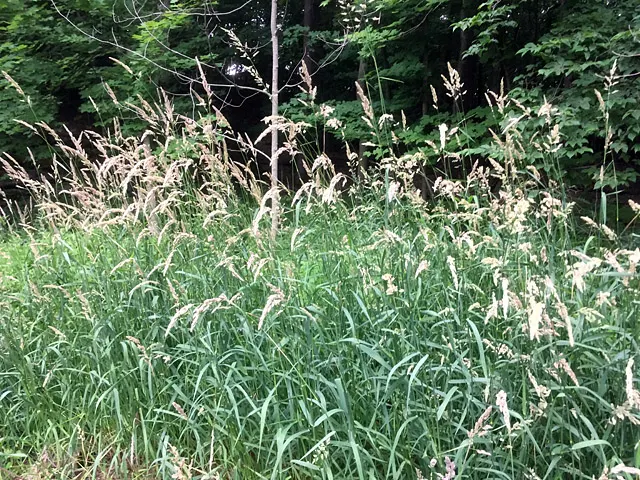The Slough
A busy life, the return of mosquitoes and then the ever more aggravating deer fly, have kept me from the woods -through which I must pass to get to the back slough. The slough, a small natural woodland basin bordered on its west by an old gravel pit, has become wetter over the last decade. Prior owners of the neighboring pit decided it would be more useful filled and so introduced a stream of trucks dumping their fill. We believe this raised the water table and is the reason our woodland vernal pond supporting silver maples and green ash has become a permanent swamp; one that has dried, only temporarily, a couple of years out of ten. The last of the trees within its bounds has died and the aggressively spreading, wet soil tolerant canary reed grass has taken hold in the newly sunny slough.
Yesterday morning a meso-scale storm passing just to our north provided a strong draft and mosquito-free window to pass through the woods. The last time I gazed upon this rapidly changing two acres it was a pond pushing beyond its bounds. Now, the lower water table of summer has changed it to a burgeoning meadow; the remains of duckweed sitting on a crust of drying muck.
 |
| Canary Reed Grass, Phalaris arundinacea |
It is a surprise to see the blue flag, Iris versicolor, I planted two years ago continuing to bulk up, maybe even thrive, despite the competition from so much mad dog skullcap, Scutellaria lateriflora.
I purchased seeds of another grass, prairie cord grass, but have been hesitant to distribute the seeds. It is a native, warm season slough grass that I intended to use as a foil to the cool season canary reed grass. Like canary, it spreads by rhizomes and can be aggressive. Although it grows all over Minnesota, further reading led me to think that the six to eight foot grass may not be the right choice. I'd rather be out ten dollars in seed than dealing with another grass, not currently present, that then spreads too widely. My curiosity, however, gets the best of me -I have tray-seeded a few to see how they grow.
As more storms approached from the north, I pressed on toward the little wetland to see how it has changed since the high water of late spring. Water sheds from the surrounding moraine, draining through two gullies, then filters through two wetlands to pool at the bottleneck that leads to our driveway culvert. Earlier this spring I cleared the growing stand of buckthorn from the floodplain surrounding the bottleneck. Dying ash and falling box elder have opened the canopy here, letting in more sun.
In early June I made an attempt to slow the spread of canary reed grass weakened by five weeks of flood waters. Wearing knee high rubber boots, I cut any grass growing along the perimeter of the open water with a weed trimmer. Although it has come back now that the water has receded, it has done so less vigorously -a rather minor victory. If I want to maintain open water here, or better yet, introduce sedge and other wetland plants, I'll need to continue to fight back the canary reed grass which has a stranglehold on much of the small wetland.
Last Saturday I spent an hour at a nearby natural landscape contractor's end of season native plant sale. Most of my purchases (only $2.50 per plant!) were infill for my prairie plantings, but I did buy a couple of wetland plants. Above, ironweed, Vernonia fasciculata, has a wetland indicator status of facultative (FACW). This means it usually occurs in wetlands -66 to 99 percent of the time. This wetland status and my failure to grow it successfully in my dry Brooklyn garden led me to choose the flood plain as its new home.
My other purchase, broad-leaved arrowhead, Sagittaria latifolia, has a wetland status of obligate wetland (OBL) which means that it occurs in wetlands nearly 100 percent of the time. This plant prefers standing water and at least partial sun, so I placed in the pool that collects at the bottleneck, a stones throw from the ironweed.
My other purchase, broad-leaved arrowhead, Sagittaria latifolia, has a wetland status of obligate wetland (OBL) which means that it occurs in wetlands nearly 100 percent of the time. This plant prefers standing water and at least partial sun, so I placed in the pool that collects at the bottleneck, a stones throw from the ironweed.
We've been in a very wet period, receiving several inches of rain over the last two weeks. The tropical air and daily storms are expected to last through the week. Over the last 24 hours we've received over 3 inches of rain, and another three plus within the last ten days, bringing the water table back up to where it was in late May. This morning, braving the mosquitoes, I ventured to see the arrowhead I planted two days back -but it is missing, most likely it has tipped over into the muck under the rising water.







Comments
Post a Comment
Go ahead and comment! I will moderate and delete the spam. Thx